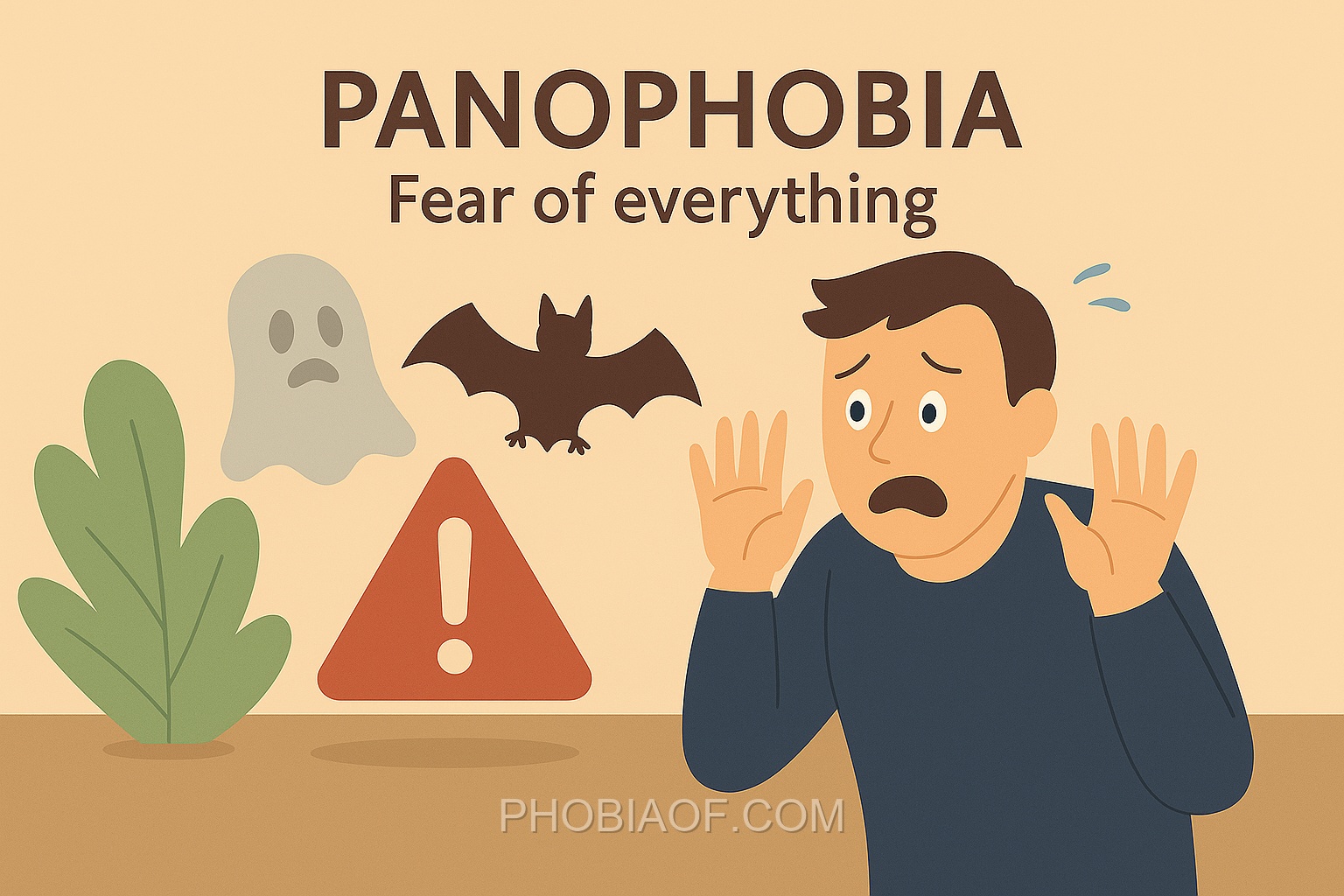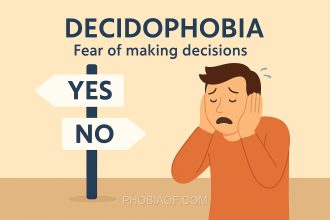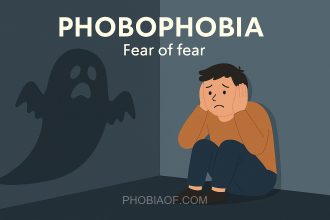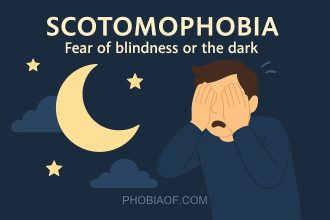Have you ever felt anxious without knowing exactly why? Imagine if that feeling extended to almost everything in your environment. This is the reality for those who experience Panophobia, a condition often referred to as the fear of everything.
Panophobia is derived from Greek roots: “pan” meaning “all” and “phobos” meaning “fear.” It describes a persistent, generalized fear that can encompass various situations, objects, and experiences, creating a pervasive sense of anxiety that is difficult to pinpoint to a specific source.
For individuals dealing with Panophobia, life can feel like navigating a constant state of alertness and apprehension. This condition can manifest in several ways and affect people generally by:
- Causing overwhelming anxiety that impacts daily functioning.
- Leading to avoidance behaviors, where individuals steer clear of places or activities due to a vague sense of dread.
- Contributing to physical symptoms such as rapid heartbeat, sweating, and dizziness during episodes of fear.
- Interfering with social interactions and relationships, as the fear can make it challenging to engage with others.
Understanding Panophobia with compassion is crucial. Recognizing its impact can foster empathy and support for those striving to manage this complex and often misunderstood condition.
Causes of Panophobia
Panophobia, often described as a fear of everything, can be a complex and overwhelming condition. Understanding its causes can help in managing and addressing this phobia effectively. Below are some potential causes of panophobia:
- Genetic Predisposition: Like many anxiety disorders, panophobia may have a genetic component. Individuals with a family history of anxiety or phobic disorders might be more susceptible to developing panophobia themselves. This genetic predisposition can play a significant role in how someone processes fear and anxiety.
- Traumatic Experiences: Past traumatic events can contribute to the development of panophobia. Experiencing or witnessing a traumatic event might create a lasting impact on an individual’s psyche, leading them to develop a generalized fear of various situations or objects.
- Learned Behavior from Others: Observing or growing up with family members who exhibit fearful or anxious behavior can influence an individual to develop similar phobic responses. This learned behavior can be especially potent in formative years when children are highly impressionable.
- Psychological Factors: Other underlying psychological conditions, such as generalized anxiety disorder or depression, can also contribute to the development of panophobia. These conditions may exacerbate feelings of fear and anxiety, making it seem as if the individual is afraid of everything.
- Environmental Factors: Stressful environments or significant life changes, such as moving to a new place or changing jobs, can increase anxiety levels, potentially leading to panophobia. The constant feeling of being overwhelmed can trigger or worsen phobic responses.
While these are some common causes, it’s important to note that the exact origin of panophobia can vary from person to person. Some interesting theories suggest that it could be an evolutionary response, where an overactive fear response might have been advantageous in ancient environments but is less so in modern life.
Understanding these causes can be a crucial step in seeking appropriate treatment and support for those experiencing panophobia. Therapy, medication, and lifestyle changes are often used to manage this condition effectively.
Symptoms of Panophobia
Panophobia, often described as a generalized fear of everything, can be an overwhelming condition. Individuals experiencing this phobia may feel an intense sense of fear or anxiety that seems to have no specific focus or trigger. This pervasive fear can significantly impact one’s emotional and physical well-being. Below are some common symptoms that may help in identifying panophobia:
Physical Symptoms:
- Panic attacks marked by intense fear and a sense of impending doom.
- Profuse sweating, even in the absence of physical exertion.
- Rapid heartbeat, often described as feeling like the heart is racing.
- Shortness of breath or hyperventilation.
- Trembling or shaking, which may be visible or felt internally.
- Dizziness or a feeling of lightheadedness.
- Nausea or gastrointestinal distress.
Emotional and Behavioral Symptoms:
- Avoidance of situations or environments that might trigger anxiety.
- Persistent and overwhelming dread of vague or unknown threats.
- Difficulty concentrating or staying focused due to intrusive anxious thoughts.
- Feeling detached from reality or experiencing a sense of unreality.
- Excessive worry about future events, leading to a heightened state of vigilance.
- Withdrawal from social activities or relationships due to fear.
When panophobia is severe, these symptoms can profoundly interfere with daily life, making it challenging to maintain routines, relationships, and overall quality of life.
Treatment for Fear of Everything
Experiencing a fear of everything, known as Panophobia, can feel overwhelming. However, it is important to know that this phobia can be treated and managed over time. With the right approach and support, you can work towards overcoming these fears and leading a fulfilling life.
Proven Therapies
There are several effective therapeutic approaches to help manage and reduce the symptoms of Panophobia:
- Exposure Therapy: This involves gradually facing your fears in a controlled and safe environment. The goal is to desensitize you to the triggers that cause anxiety, helping you build confidence over time.
- Cognitive-Behavioral Therapy (CBT): CBT focuses on changing the negative and fearful thoughts that contribute to your anxiety. By identifying and challenging these thoughts, you can develop healthier thinking patterns that reduce fear.
- Counseling: Speaking with a mental health professional can provide a supportive space to explore your fears and develop coping strategies tailored to your needs.
Self-Help Coping Techniques
In addition to professional therapy, there are several self-help techniques that can complement your treatment:
- Relaxation Exercises: Practices such as deep breathing or progressive muscle relaxation can help reduce the physical symptoms of anxiety.
- Meditation: Regular meditation practice can promote a sense of calm and help you manage stress more effectively.
- Support Groups: Connecting with others who experience similar fears can provide encouragement and practical advice for managing anxiety.
Medication
In some cases, medication such as anti-anxiety medications may be prescribed, particularly if the phobia is severe. However, the focus remains on therapy and developing coping skills to address the root causes of the fear.
Remember, you are not alone, and seeking professional help can be a crucial step toward overcoming Panophobia. With time, patience, and the right support, you can learn to manage your fears and reclaim your life.
We encourage you to reach out to a mental health professional if your phobia is interfering with your daily life. Taking the first step can lead to meaningful improvements and greater peace of mind.
Conclusion
Understanding the causes and symptoms of Panophobia, often referred to as the fear of everything, is a crucial step toward empowerment and recovery. By recognizing the underlying factors and manifestations of this complex phobia, individuals can begin to address their fears with greater clarity and confidence. Knowledge equips you with the tools necessary to tackle the overwhelming nature of Panophobia, transforming the seemingly insurmountable into manageable challenges.
It’s important to remember that many people have successfully managed or even overcome their phobias with time, patience, and the right support. If you or someone you know is struggling with Panophobia, consider seeking professional help. Therapy and medical guidance can provide valuable strategies and support systems tailored to your unique needs.
Take heart in the fact that you are not alone, and there is hope for a brighter, more fearless future. Reach out to a therapist or consult with a doctor to explore your options and start your journey toward overcoming Panophobia today.






